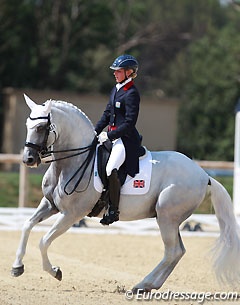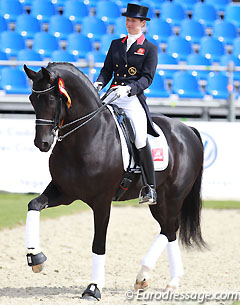
Many of us have headed off to the local physician to complain about a sudden sharp pain or general ache, and the doctor has turned to us and said, "oh yes but horse riding is so relaxing." They of course imagine that we just sort of lull about on endless trail rides, smelling the roses as we go. The demands of dressage is a little more challenging and if you strive for a relaxed position on the horse, a supple back, an open hip, a relaxed leg and a gentle hand, the truth is it takes a lot more strength and physical elasticity than most would presume.
“A good piece of advice to all who want to ride well, and who wish to acquire a good position, would be to do gymnastic exercises; which give suppleness, ease and sureness in riding. The nearer the rider approaches an ideal position, the more he will succeed in difficult exercises without apparent movements of gestures, leaving the observer with the impression of total harmony between horse and rider,” said my idol Nuno Oliveira.
Ahead of his time in a range of things, Nuno adviced truly. Unless you want to be pilled up to the eyeballs, the key to a relaxed and comfortable position, is actually in working your body in a range of different ways. Some use yoga, or pilates, or strength training, swimming, boxing cycling, whatever it may be, that helps teach your body to work in other ways, in other positions, so that your position in the saddle has greater movement, greater elasticity and balance.
When I set out to find my ideal body booster, I started a core training program with “The Core Training for Equestrians” to help me push through my own mental hurdles and build muscle in areas that hadn’t been used in quite some time. It took time for me to build my confidence, but gradually as I built up the muscle, I began to use my body in new ways, and thus develop a greater sense of what my body was doing and when.
British Olympian Laura Tomlinson-Bechtolscheimer uses pilates, which she undertakes twice a week with her instructor, and has done so for over 8 years.
 “I do some sort of cardio about 3 times a week depending on where I am in the world and if competing or not! For example, I run every day if I am in Argentina with my husband, and in England I run in the summer but in winter I cycle (indoors) or swim.”
“I do some sort of cardio about 3 times a week depending on where I am in the world and if competing or not! For example, I run every day if I am in Argentina with my husband, and in England I run in the summer but in winter I cycle (indoors) or swim.”
While Laura says she has a pretty strong core, she struggles to keep her neck and shoulders relaxed. She admits that for her they are the first places where tension creeps in and this can have a knock on effect on the rest of her body.
“If I keep my shoulders relaxed and down I will stay even and my arms and hands will stay soft too. The hours I spend in the saddle are long so how I sit is vital for keeping my body able for longer," said Tomlinson. Laura added that regular physiotherapy is vital too.
I suggest that once you have found the right form of body work, to increase your elasticity and strength, you will typically also need to find ways in order to relieve pain and relax. Even if we work our bodies and set ourselves up to be prepared for riding, our horses are animals and on occasion will jump sideways. Even the quietest horse can trip and cause us to lurch forward and pull ourselves in all different directions.
Finding the right traditional or alternative form of treatment can be tricky, particularly as many professionals may be very good at what they do, but not understand what we do.
by Sarah Warne
Related Links
Sarah Warne's Classical Training Articles
Horses for Courses: Anna Johnson Reflects on Physiotherapy for Horse and Human
An Afternoon in the Field with the Physiotherapist